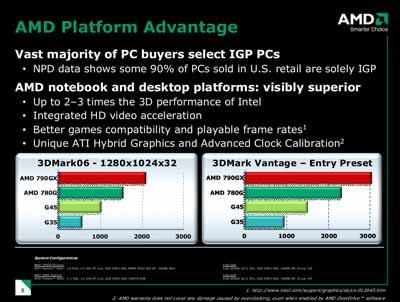Before Intel's big show, AMD launches an attack

With Intel's annual conference set to start this week, AMD launched a pre-emptive strike in a press conference on Friday.
AMD executives said the processor innovations you'll hear about next week are imitations of technology they introduced as much as five years ago, and Intel's Larrabee graphics architecture remains little more than a PowerPoint slide. For its part, AMD did not announce any new products or changes to its roadmap, but they said the company had gotten its "swagger" back, releasing a string of competitive PC platforms and graphics products this year.
This week Intel will release more details on its Nehalem architecture, the first iteration of which is now known as Core i7. Randy Allen, the senior vice president of AMD's computing division, said many innovations in Core i7 are really imitations of features such as the integrated memory controller and HyperTransport already in AMD processors.
"I guess on one level it is sort of gratifying. Imitation is the sincerest form of flattery," Allen said. "But on another level it is somewhat annoying . . . [Nehalem is] not rewriting the book, but rather imitating or photocopying our innovations."
AMD showed a series of benchmark results to demonstrate that Opteron is still the one to beat on applications such as Web servers, virtualization, databases and high-performance computing. The upcoming 45nm processor, code-named Shanghai, is already in production, and Allen said it was meeting or exceeding the company's targets for frequency, yield and schedule. AMD will ship 45nm server processors to OEMs in the fourth quarter of this year, "closely followed" by client chips.
Intel already sells 45nm processors, and it is expected to release a handful of new 45nm server and high-end desktop chips, based on the Core i7 microarchitecture, by the end of the year. But AMD thinks it will be a long time before Intel gets 2P and 4P server versions of Nehalem out the door. That could be significant because features such as the integrated memory controller in Opteron and Shanghai, as well Core i7, really shine on those types of servers. Intel declined to comment on AMD's characterization of its server plans.
Allen conceded the current Phenom desktop and Turion Ultra laptop processors can't match Intel's fastest chips, but he said AMD's PC platforms were better-positioned in the broader market. "The market has shifted away from that performance crown. It's a nice halo to have, and we certainly have plans there," he said. "But in terms of what really matters, we exceed the requirements of the value and mainstream segments."
Rick Bergman, the senior vice president of AMD's graphics group, had the easier job, essentially a victory lap after the company's new 4800 series GPUs--which he called the "first teraflops semiconductor device, period"--beat out Nvidia's GT200. AMD is also on a roll with integrated graphics having released both the M780G (Puma) for laptops and 790FX for desktops--both of which use Radeon HD 3000 series IGPs. "Our visual experience is two to three times better than our competitor," Bergman said, referring to Intel. "We have a clear performance lead over the G35 and G45."
The performance of Intel's latest integrated graphics was the subject of a dust-up last week after a video called "AMD Intel Mobile Challenge" compared the ATI Radeon HD 3200 and Intel Graphics Media Accelerator X4500 on similarly-priced HP Pavilion dv5 mainstream notebooks, and appeared to show flaws in Intel's Blu-ray HD video playback. An Intel blogger fired back, but ended up admitting that the G35/G45 has some issues that will hopefully be addressed by future driver updates. AMD has also posted YouTube video comparing game-play on the two platforms (Intel's G35, in this case).
There's no doubt that AMD's product portfolio is in much better shape than it was a year ago. But Intel continues to gain market share in microprocessors, according to IDC's figures. In the second quarter, Intel's processor shipments grew more than 4%, and nearly 21% compared with the same quarter a year ago, while AMD's shipments were flat. That pushed Intel's share of the overall market to just shy of 80%, while AMD lost more than a percentage point and slipped below 20% overall.
